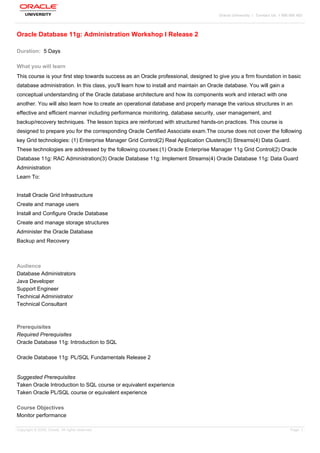Oracle Database 11g Administration Workshop I Release 2
- 1. Oracle University | Contact Us: 1 800 005 453
Oracle Database 11g: Administration Workshop I Release 2
Duration: 5 Days
What you will learn
This course is your first step towards success as an Oracle professional, designed to give you a firm foundation in basic
database administration. In this class, you'll learn how to install and maintain an Oracle database. You will gain a
conceptual understanding of the Oracle database architecture and how its components work and interact with one
another. You will also learn how to create an operational database and properly manage the various structures in an
effective and efficient manner including performance monitoring, database security, user management, and
backup/recovery techniques. The lesson topics are reinforced with structured hands-on practices. This course is
designed to prepare you for the corresponding Oracle Certified Associate exam.The course does not cover the following
key Grid technologies: (1) Enterprise Manager Grid Control(2) Real Application Clusters(3) Streams(4) Data Guard.
These technologies are addressed by the following courses:(1) Oracle Enterprise Manager 11g Grid Control(2) Oracle
Database 11g: RAC Administration(3) Oracle Database 11g: Implement Streams(4) Oracle Database 11g: Data Guard
Administration
Learn To:
Install Oracle Grid Infrastructure
Create and manage users
Install and Configure Oracle Database
Create and manage storage structures
Administer the Oracle Database
Backup and Recovery
Audience
Database Administrators
Java Developer
Support Engineer
Technical Administrator
Technical Consultant
Prerequisites
Required Prerequisites
Oracle Database 11g: Introduction to SQL
Oracle Database 11g: PL/SQL Fundamentals Release 2
Suggested Prerequisites
Taken Oracle Introduction to SQL course or equivalent experience
Taken Oracle PL/SQL course or equivalent experience
Course Objectives
Monitor performance
Copyright © 2009, Oracle. All rights reserved. Page 1
- 2. Describe Oracle Database Architecture
Install Oracle Grid Infrastructure
Install and configure Oracle Database 11g
Configure Oracle Net services
Monitor and administer undo data
Manage the database storage structures
Create and administer user accounts
Perform basic backup and recovery of a database
Manage users and schemas
Manage data concurrency
Course Topics
Exploring the Oracle Database Architecture
Oracle Database Architecture Overview
Oracle ASM Architecture Overview
Process Architecture
Memory structrues
Logical and physical storage structures
ASM storage components
Installing your Oracle Software
Tasks of an Oracle Database Administrator
Tools Used to Administer an Oracle Database
Installation: System Requirements
Oracle Universal Installer (OUI)
Installing Oracle Grid Infrastructure
Installing Oracle Database Software
Silent Install
Creating an Oracle Database
Planning the Database
Using the DBCA to Create a Database
Password Management
Creating a Database Design Template
Using the DBCA to Delete a Database
Managing the Oracle Database Instance
Start and stop the Oracle database and components
Use Oracle Enterprise Manager
Access a database with SQLPlus
Modify database installation parameters
Describe the stages of database startup
Describe database shutdown options
View the alert log
Access dynamic performance views
Manage the ASM Instance
Set up initialization parameter files for ASM instance
Start up and shut down ASM instances
Administer ASM disk groups
Copyright © 2009, Oracle. All rights reserved. Page 2
- 3. Configuring the Oracle Network Environment
Use Enterprise Manager to create and configure the Listener
Enable Oracle Restart to monitor the listener
Use tnsping to test Oracle Net connectivity
Identify when to use shared servers and when to use dedicated servers
Managing Database Storage Structures
Storage Structures
How Table Data Is Stored
Anatomy of a Database Block
Space Management in Tablespaces
Tablespaces in the Preconfigured Database
Actions with Tablespaces
Oracle Managed Files (OMF)
Administering User Security
Database User Accounts
Predefined Administrative Accounts
Benefits of Roles
Predefined Roles
Implementing Profiles
Managing Data Concurrency
Data Concurrency
Enqueue Mechanism
Resolving Lock Conflicts
Deadlocks
Managing Undo Data
Data Manipulation
Transactions and Undo Data
Undo Data Versus Redo Data
Configuring Undo Retention
Implementing Oracle Database Auditing
Describe DBA responsibilities for security
Enable standard database auditing
Specify audit options
Review audit information
Maintain the audit trail
Database Maintenance
Manage optimizer statistics
Manage the Automatic Workload Repository (AWR)
Use the Automatic Database Diagnostic Monitor (ADDM)
Describe and use the advisory framework
Set alert thresholds
Use server-generated alerts
Use automated tasks
Performance Management
Performance Monitoring
Copyright © 2009, Oracle. All rights reserved. Page 3
- 4. Managing Memory Components
Enabling Automatic Memory Management (AMM)
Automatic Shared Memory Advisor
Using Memory Advisors
Dynamic Performance Statistics
Troubleshooting and Tuning Views
Invalid and Unusable Objects
Backup and Recovery Concepts
Part of Your Job
Statement Failure
User Error
Understanding Instance Recovery
Phases of Instance Recovery
Using the MTTR Advisor
Media Failure
Archive Log Files
Performing Database Backups
Backup Solutions: Overview
Oracle Secure Backup
User-Managed Backup
Terminology
Recovery Manager (RMAN)
Configuring Backup Settings
Backing Up the Control File to a Trace File
Monitoring the Flash Recovery Area
Performing Database Recovery
Opening a Database
Data Recovery Advisor
Loss of a Control File
Loss of a Redo Log File
Data Recovery Advisor
Data Failures
Listing Data Failures
Data Recovery Advisor Views
Moving Data
Describe ways to move data
Create and use directory objects
Use SQL*Loader to move data
Use external tables to move data
General architecture of Oracle Data Pump
Use Data Pump export and import to move data
Working with Support
Use the Enterprise Manager Support Workbench
Work with Oracle Support
Log service requests (SR)
Manage patches
Copyright © 2009, Oracle. All rights reserved. Page 4
